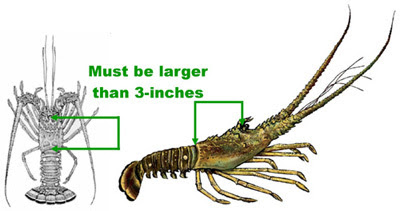
FWC – Today, spiny lobster regular recreational and commercial season begins.
The two-day sports season last week successfully wrapped up, and lobster lovers everywhere are now getting ready for the regular recreational and commercial season, which starts Aug. 6 and runs through March 31, 2018. This economically important season generates more than $1 million through the sales of more than 200,000 spiny lobster permits annually.
“Based on what we saw during the two-day mini-season last month, we look forward to successful recreational harvests as well as ample opportunities for Florida’s robust commercial fishing industry,” said FWC Chairman Brian Yablonski.
Planning on catching some of these tasty crustaceans? Here is what you need to know before you go.
Where to harvest
Know where you can go. Lobster harvest is always prohibited in Everglades National Park, Dry Tortugas National Park, Biscayne Bay-Card Sound Spiny Lobster Sanctuary, certain areas of John Pennekamp Coral Reef State Park, and no-take areas in the Florida Keys National Marine Sanctuary. Visit MyFWC.com/Fishing and click on “Saltwater Fishing,” “Recreational Regulations,” “Lobster” and “Regulations for Recreational Harvest and Lobster Information for Monroe County” to learn more about areas in Monroe County that are open to spiny lobster harvest.
Bag limits
Stick to the bag and possession limits so there will be enough lobsters for all your friends and family. The daily recreational bag and on-the-water possession limit are six spiny lobsters per person for all Florida waters.
Size limit
No one wants a small lobster for dinner, and recently approved legislation specifies that each undersized spiny lobster found in a violator’s possession may be charged as a separate offense. In addition, recreational or commercial violators with 100 or more undersized spiny lobsters are to be charged with a third-degree felony. Remember to always check the size of lobster you catch. If the carapace length is not larger than 3 inches, it may not be harvested (see image on how to measure spiny lobster). For divers, measuring devices are required and lobsters must be measured while they are in the water.
Egg-bearers
To protect the next generation and your future chances to have lobster for dinner, the harvest of egg-bearing females is prohibited. Egg-bearing lobsters have hundreds of thousands of eggs attached under the tail that is easily visible. While most lobsters have completed reproduction by the start of the fishing season, finding lobsters with eggs is common in July and August.
Bully netting
Bully netting at night is a popular method of harvest. Keep in mind, bright lights and loud noise on the water late at night can be disruptive. Keep lights directed down and avoid shining lights at houses along the shoreline. Keep sound levels low when near shoreline residences. Bully netters have a right to fish but should be courteous of others by minimizing disruptions and not trespassing on private property.
Whole condition
Bring a cooler big enough to hold the entire lobster. Spiny lobsters must remain in whole condition until they are brought to shore. Also, do not take spiny lobster with any device that might puncture, penetrate or crush its shell.
Licenses and permits
Make sure to have the proper paperwork. A recreational saltwater fishing license and a spiny lobster permit are required to recreationally harvest spiny lobsters unless you are exempt from recreational license requirements. Information about these licenses and permits is available online at MyFWC.com/License or you may purchase your license today at GoOutdoorsFlorida.com.
FWC said that boaters should also remember diving safety tips while out on the water.
